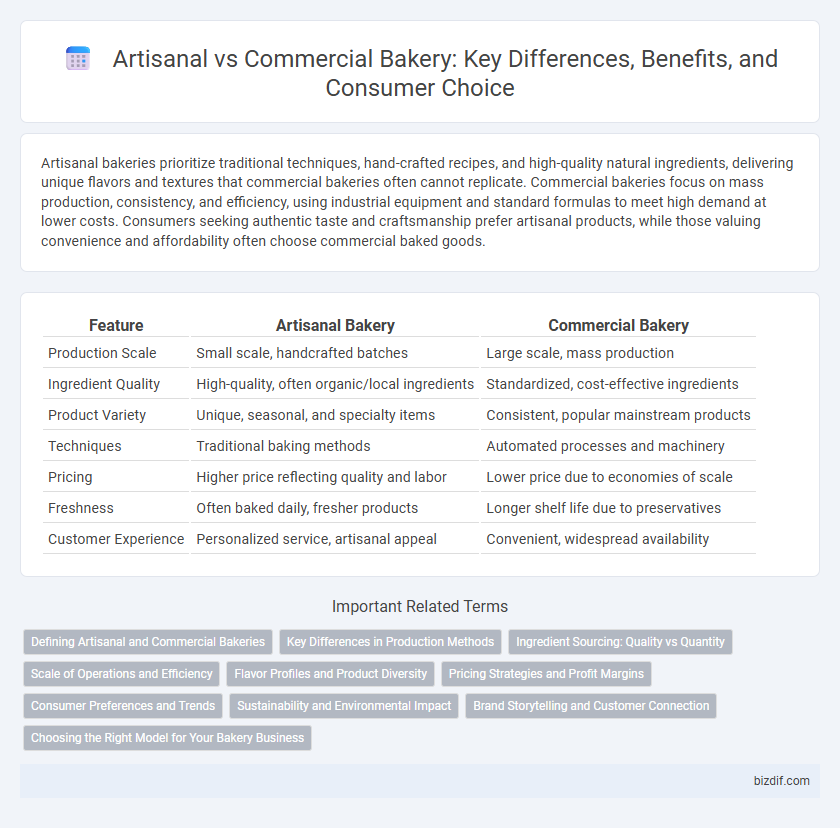Artisanal bakeries prioritize traditional techniques, hand-crafted recipes, and high-quality natural ingredients, delivering unique flavors and textures that commercial bakeries often cannot replicate. Commercial bakeries focus on mass production, consistency, and efficiency, using industrial equipment and standard formulas to meet high demand at lower costs. Consumers seeking authentic taste and craftsmanship prefer artisanal products, while those valuing convenience and affordability often choose commercial baked goods.
Table of Comparison
| Feature | Artisanal Bakery | Commercial Bakery |
|---|---|---|
| Production Scale | Small scale, handcrafted batches | Large scale, mass production |
| Ingredient Quality | High-quality, often organic/local ingredients | Standardized, cost-effective ingredients |
| Product Variety | Unique, seasonal, and specialty items | Consistent, popular mainstream products |
| Techniques | Traditional baking methods | Automated processes and machinery |
| Pricing | Higher price reflecting quality and labor | Lower price due to economies of scale |
| Freshness | Often baked daily, fresher products | Longer shelf life due to preservatives |
| Customer Experience | Personalized service, artisanal appeal | Convenient, widespread availability |
Defining Artisanal and Commercial Bakeries
Artisanal bakeries emphasize handcrafted techniques, small-batch production, and high-quality, natural ingredients to create unique, flavorful breads and pastries. Commercial bakeries rely on mass production, standardized recipes, and automated processes to ensure consistency and high volume output, often using preservatives and additives. The distinction lies in the scale, ingredient selection, and production methods, with artisanal focusing on craftsmanship and commercial on efficiency.
Key Differences in Production Methods
Artisanal bakery production relies on traditional techniques, small batch processing, and manual craftsmanship, resulting in unique textures and flavors. Commercial bakery methods emphasize mechanization, large-scale production, and consistency to maximize efficiency and volume. The use of natural fermentation and high-quality, locally sourced ingredients distinguishes artisanal breads from the standardized formulas and preservatives common in commercial products.
Ingredient Sourcing: Quality vs Quantity
Artisanal bakeries prioritize ingredient sourcing by selecting high-quality, often locally-sourced and organic ingredients to enhance flavor and texture, emphasizing small-batch production. Commercial bakeries focus on quantity, using cost-effective, mass-produced ingredients to meet large-scale demand and ensure consistent supply. This difference in ingredient sourcing affects the final product's quality, with artisanal baked goods typically offering superior taste and nutritional value.
Scale of Operations and Efficiency
Artisanal bakeries emphasize small-scale production with handcrafted techniques, resulting in unique, high-quality products tailored to local tastes. Commercial bakeries operate large-scale facilities using automated processes to maximize output and efficiency, serving widespread markets with consistent products. The scale of operations directly impacts production speed, cost-efficiency, and product customization in both models.
Flavor Profiles and Product Diversity
Artisanal bakeries emphasize unique flavor profiles by using traditional methods and high-quality, often locally sourced ingredients, resulting in distinctive textures and richer tastes. Commercial bakeries focus on consistency, large-scale production, and cost efficiency, producing a narrower range of standardized products with uniform flavor. The product diversity in artisanal bakeries includes specialty breads, pastries, and seasonal items, while commercial bakeries prioritize mass-produced staples like sandwich loaves and packaged snacks.
Pricing Strategies and Profit Margins
Artisanal bakeries employ premium pricing strategies reflecting handcrafted quality and unique ingredients, resulting in higher profit margins per product despite lower volume sales. Commercial bakeries focus on economies of scale, offering lower prices driven by mass production and standardized recipes, which yields thinner profit margins compensated by large sales volume. Pricing strategies in artisanal versus commercial baking fundamentally impact profitability and market positioning within the bakery industry.
Consumer Preferences and Trends
Consumer preferences increasingly favor artisanal bakery products for their perceived quality, use of natural ingredients, and unique flavors that reflect traditional baking methods. Market trends indicate a growing demand for organic, locally sourced, and handcrafted breads and pastries, contrasting with the mass-produced consistency and lower price points of commercial bakery goods. This shift is driven by health-conscious and food-savvy consumers seeking authenticity and transparency in their food choices.
Sustainability and Environmental Impact
Artisanal bakeries prioritize sustainability by sourcing local, organic ingredients and minimizing waste through small-batch production, reducing their overall carbon footprint. Commercial bakeries often rely on mass production techniques and widespread distribution networks, leading to higher energy consumption and increased greenhouse gas emissions. Emphasizing sustainable practices in artisanal baking supports environmental health by promoting resource efficiency and reducing pollution compared to large-scale commercial operations.
Brand Storytelling and Customer Connection
Artisanal bakeries leverage authentic brand storytelling to create emotional connections, highlighting handcrafted techniques and local ingredient sourcing that resonate with discerning customers. Commercial bakeries emphasize consistent quality and scalability, often using broad marketing strategies to reach a wider audience but risk lacking personalized engagement. Customer connection in artisanal bakeries drives loyalty through transparency and community involvement, whereas commercial brands focus on convenience and product accessibility.
Choosing the Right Model for Your Bakery Business
Selecting between artisanal and commercial bakery models hinges on target market preferences and production scale. Artisanal bakeries emphasize handcrafted, high-quality ingredients and traditional techniques appealing to niche customers seeking unique flavors. Commercial bakeries prioritize mass production with consistent output and cost efficiency to supply large retailers and meet high demand.
Artisanal vs Commercial Infographic

 bizdif.com
bizdif.com